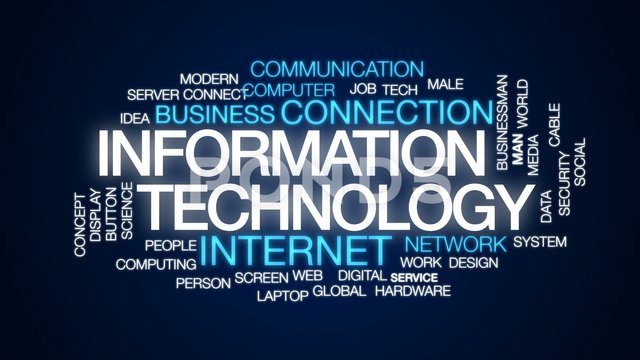Siz_Education||what is IT? And what things makes it amazing
Hlo stemians !
Hope u all r well today we know about IT.
Information Technology Definition
The phrase “information technology” goes back to a 1958 article published in the Harvard Business Review. Authors Harold J. Leavitt and Thomas L. Whisler defined several types of information technology:
Techniques for the fast processing of information
The use of statistical and mathematical models for decision-making
The “simulation of higher-order thinking through computer programs.”
“While many aspects of this technology are uncertain, it seems clear that it will move into the managerial scene rapidly, with definite and far-reaching impact on managerial organization,” they wrote.

Six decades later, it’s clear that Leavitt and Whisler were onto something big. Today, information technology refers to everything that businesses use computers for. Information technology is building communications networks for a company, safeguarding data and information, creating and administering databases, helping employees troubleshoot problems with their computers or mobile devices, or doing a range of other work to ensure the efficiency and security of business information systems.
✓5 Reasons Why the IT Industry Is a Great Career Choice:

If you’re looking into possibilities for a new profession or a career change and wondering what is a good career choice, the IT industry might be at the top of your list.
The Information Technology industry is one of the fastest-growing sectors worldwide providing jobs full of opportunities for professional success. The IT industry offers quick employment, opportunities in every sector, multiple career paths, high salaries, and it’s easy to enter this industry without a college degree.
And if you’re willing to accept the challenge it is highly rewarding throughout life. To help you make your decision, here are five reasons to start a career in IT:
- Quick Employment:
Tech companies are looking to hire IT professionals because demand is high and there aren’t enough qualified workers to fill the gap. And the trend won’t end anytime soon, as the tech industry is set to grow another 22-38% by 2020.
The demand is so high, that certified professionals can easily find work even without a college degree. While at the same time, tech students are known to freelance during their studies to generate an extra bit of cash.
√. A Variety of Career Opportunities:
Information Technology is not an isolated industry. It overlaps with every other sector, which makes it a versatile career opportunity. From healthcare to agriculture, digital transformation is driving change in all spheres of business which allows IT professionals to choose a career that aligns with their interests.
Also, there are at least 30 new emerging fields in IT that will see the full-scale application in the next five to ten years according to the Gartner Hype Cycle. So, tech professionals will be using their skills to choose many exciting career paths and drive global innovation forward.
√. Easy Career Growth
As technology improves, IT professionals evolve alongside it. It’s a job requirement. But with the constant pursuit of knowledge, it allows them to grow their careers much faster and easier than in other industries.
It is not unheard of for tech professionals to start at entry level, and move to a mid-level managerial position within a few years. Just like it is not unusual to see companies seek out talented students before they receive their degrees.
√. It Pays Well:
Tech professionals are esteemed for their unique skill sets. That makes them invaluable assets in any business. So, when it comes to their financial compensation for their work, it is substantially higher than the average norm even at junior or entry-level positions.
For example, depending on the industry and location a software engineer can earn an average salary of around $83,000, which is considerably more than the national average in the United States.
√> A Reasonable Education:
Every job in the IT industry requires a unique set of skills. To qualify for a position, candidates usually have to demonstrate the right amount of technical expertise and provide proof of education and some experience.
However, what skilled professionals don’t necessarily need is a 4-year university degree. If they have the right certification and display an aptitude for completing tasks, they usually receive an entry-level position.
And when it comes to certification training programs, they are faster and far less expensive than a full degree in Computer Sciences. So, anyone with enough desire to start a career in IT is very achievable, even when you want to start from scratch.

Conclusion:
The timing has never been better for using technology to enable and improve learning at all levels, in all places, and for people of all backgrounds. From the modernization of E-rate to the proliferation and adoption of openly licensed educational resources, the key pieces necessary to realize best the transformations made possible by technology in education are in place.
Educators, policymakers, administrators, and teacher preparation and professional development programs now should embed these tools and resources into their practices. Working in collaboration with families, researchers, cultural institutions, and all other stakeholders, these groups can eliminate inefficiencies, reach beyond the walls of traditional classrooms, and form strong partnerships to support everywhere, all-the-time learning.
Although the presence of technology does not ensure equity and accessibility in learning, it has the power to lower barriers to both in ways previously impossible. No matter their perceived abilities or geographic locations, all learners can access resources, experiences, planning tools, and information that can set them on a path to acquiring expertise unimaginable a generation ago.
All of this can work to augment the knowledge, skills, and competencies of educators. Tools and data systems can be integrated seamlessly to provide information on student learning progress beyond the static and dated scores of traditional assessments. Learning dashboards and collaboration and communication tools can help connect teachers and families with instantaneous ease. This all is made more likely with the guidance of strong vision and leadership at all levels from teacher-leaders to school, district, and state administrators. For these roles, too, technology allows greater communication, resource sharing, and improved practice so that the vision is owned by all and dedicated to helping every individual in the system improve learning for students.
Hope it will help u 🙌 and after studying it u have potential to talk about something IT .
Information technology is a very big technology. Thank you for sharing your knowledge with us.
Thnks 🙌 for your appreciation
Its really very big technology in this world. We never forget its advantages. Thanks for sharing this informative post related to IT and keep sharing your more ideas with us.
Best of Luck!
Your post content is plagiarized. Its your second post which is plagiarized. Try to post unique and original content according to community rules and regulations.
https://smallseotools.com/view-report/b3ca814decfd3b7dac9776dee268c62f
Ookk